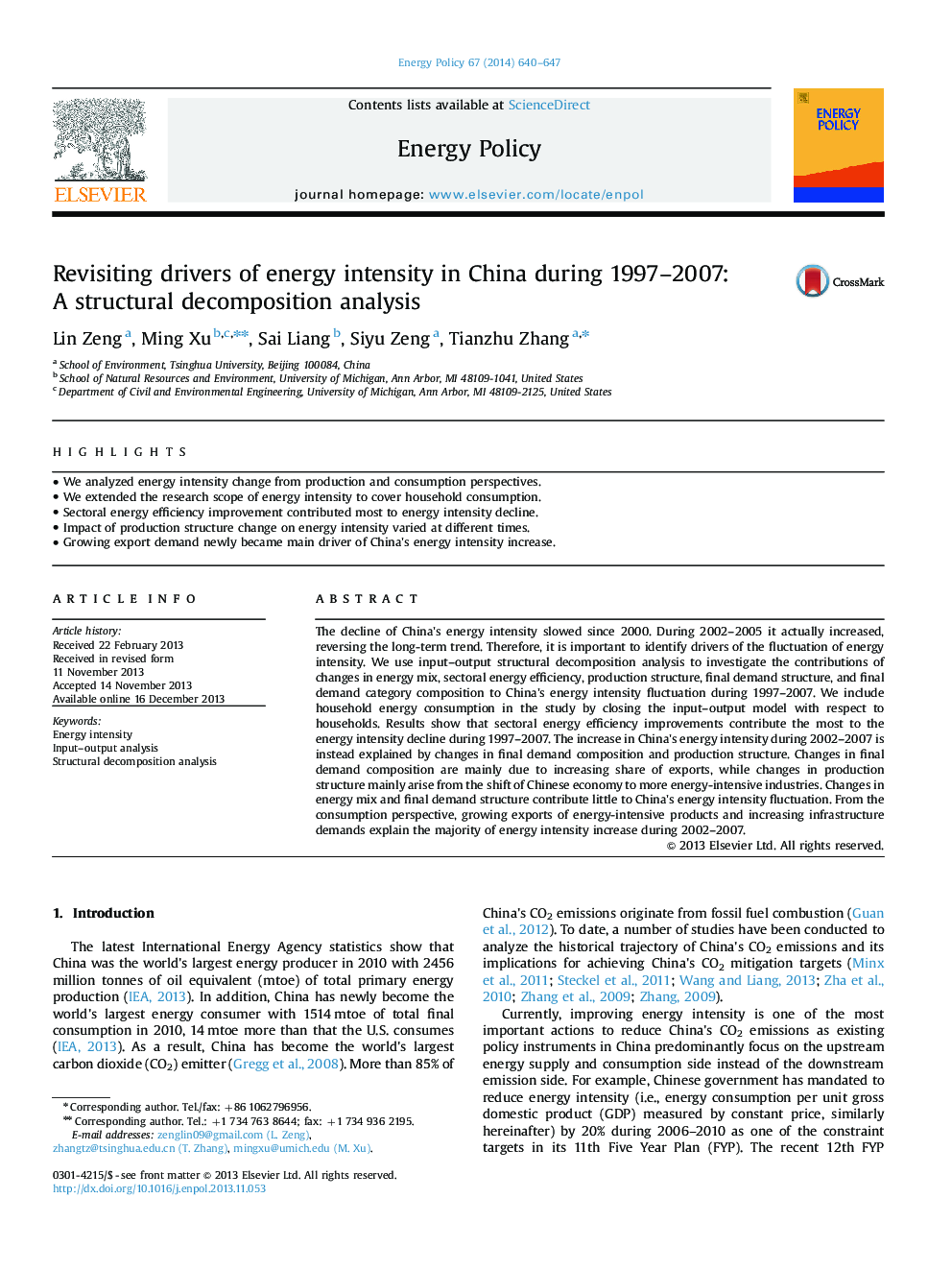| کد مقاله | کد نشریه | سال انتشار | مقاله انگلیسی | نسخه تمام متن |
|---|---|---|---|---|
| 7402633 | 1481291 | 2014 | 8 صفحه PDF | دانلود رایگان |
عنوان انگلیسی مقاله ISI
Revisiting drivers of energy intensity in China during 1997-2007: A structural decomposition analysis
ترجمه فارسی عنوان
بازنگری رانندگان شدت انرژی در چین طی سال های 1997-2007: تحلیل تجزیه ساختاری
دانلود مقاله + سفارش ترجمه
دانلود مقاله ISI انگلیسی
رایگان برای ایرانیان
کلمات کلیدی
شدت انرژی، تجزیه و تحلیل خروجی ورودی، تجزیه تجزیه ساختاری،
ترجمه چکیده
کاهش شدت انرژی چین از سال 2000 کاهش یافته است. در طول سالهای 2002-2005، در واقع روند افزایش طولانی مدت آن را افزایش داد. بنابراین مهم است که رانندگان نوسانات شدت انرژی را شناسایی کنند. ما از تجزیه و تحلیل تجزیه ساختاری ورودی-خروجی برای بررسی مشارکت تغییرات در ترکیب انرژی، بهره وری انرژی بخش، ساختار ساختار، ساختار تقاضای نهایی و ترکیب تقاضای نهایی تقاضا برای نوسانات شدت انرژی چین طی 1997-2007 استفاده می کنیم. ما با استفاده از بسته شدن مدل ورودی-خروجی به خانواده ها، مصرف انرژی خانوار را در مطالعه بررسی می کنیم. نتایج نشان می دهد که بهبود بخش های انرژی در بخش انرژی به بیشترین میزان کاهش شدت انرژی در طول سال های 1997-2007 کمک می کند. در عوض افزایش شدت انرژی چین طی سالهای 2002 تا 2007، تغییرات در ترکیب تقاضای نهایی و ساختار تولید را توضیح می دهد. تغییرات در ترکیب تقاضای نهایی عمدتا به دلیل افزایش سهم صادرات است، در حالیکه تغییرات در ساختار تولید به طور عمده ناشی از تغییر چینی به صنایع بیشتر انرژی است. تغییرات در ترکیب انرژی و ساختار تقاضای نهایی باعث کاهش نوسانات شدت انرژی چین می شود. از دیدگاه مصرف، رشد صادرات محصولات با انرژی پر مصرف و افزایش نیاز به زیرساخت، بیشترین افزایش شدت انرژی در طول سال های 2002 تا 2007 را توضیح می دهد.
موضوعات مرتبط
مهندسی و علوم پایه
مهندسی انرژی
مهندسی انرژی و فناوری های برق
چکیده انگلیسی
The decline of China's energy intensity slowed since 2000. During 2002-2005 it actually increased, reversing the long-term trend. Therefore, it is important to identify drivers of the fluctuation of energy intensity. We use input-output structural decomposition analysis to investigate the contributions of changes in energy mix, sectoral energy efficiency, production structure, final demand structure, and final demand category composition to China's energy intensity fluctuation during 1997-2007. We include household energy consumption in the study by closing the input-output model with respect to households. Results show that sectoral energy efficiency improvements contribute the most to the energy intensity decline during 1997-2007. The increase in China's energy intensity during 2002-2007 is instead explained by changes in final demand composition and production structure. Changes in final demand composition are mainly due to increasing share of exports, while changes in production structure mainly arise from the shift of Chinese economy to more energy-intensive industries. Changes in energy mix and final demand structure contribute little to China's energy intensity fluctuation. From the consumption perspective, growing exports of energy-intensive products and increasing infrastructure demands explain the majority of energy intensity increase during 2002-2007.
ناشر
Database: Elsevier - ScienceDirect (ساینس دایرکت)
Journal: Energy Policy - Volume 67, April 2014, Pages 640-647
Journal: Energy Policy - Volume 67, April 2014, Pages 640-647
نویسندگان
Lin Zeng, Ming Xu, Sai Liang, Siyu Zeng, Tianzhu Zhang,
